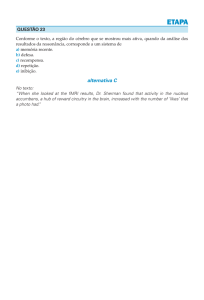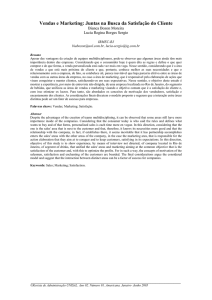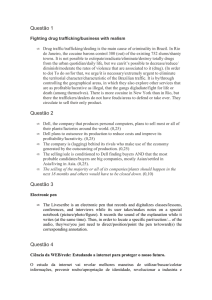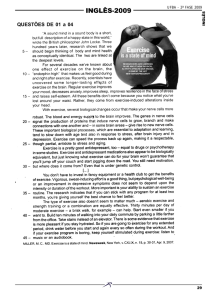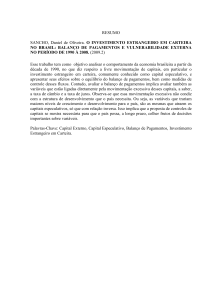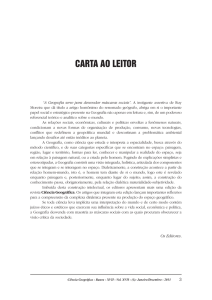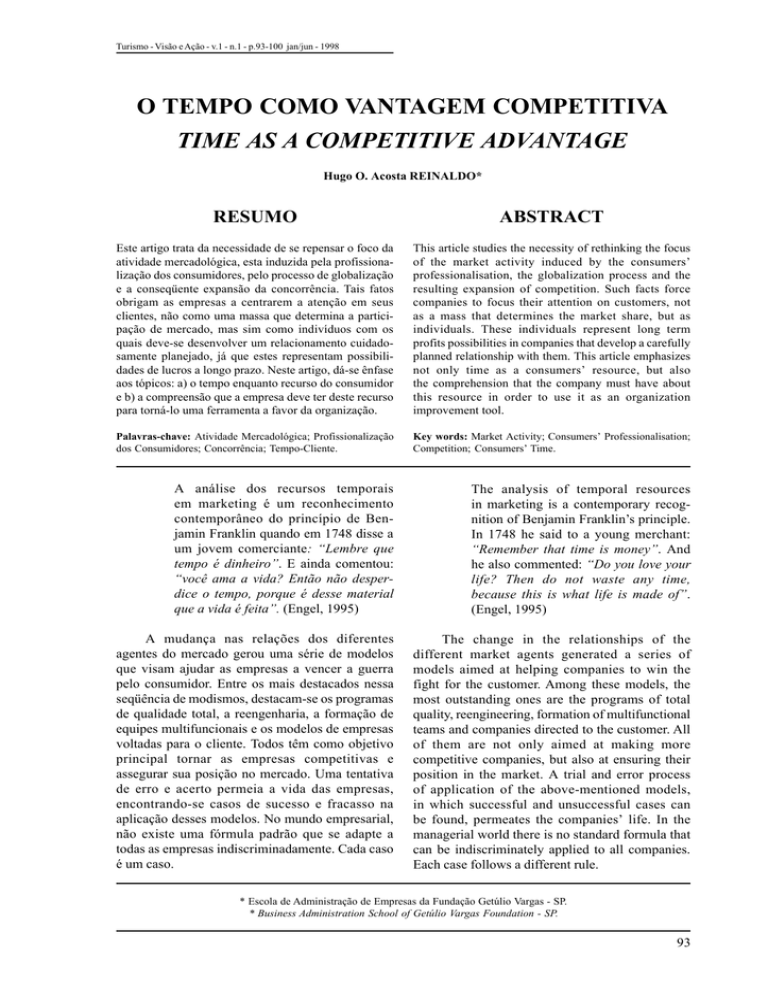
Turismo - Visão e Ação - v.1 - n.1 - p.93-100 jan/jun - 1998
O TEMPO COMO VANTAGEM COMPETITIVA
TIME AS A COMPETITIVE ADVANTAGE
Hugo O. Acosta REINALDO*
RESUMO
ABSTRACT
Este artigo trata da necessidade de se repensar o foco da
atividade mercadológica, esta induzida pela profissionalização dos consumidores, pelo processo de globalização
e a conseqüente expansão da concorrência. Tais fatos
obrigam as empresas a centrarem a atenção em seus
clientes, não como uma massa que determina a participação de mercado, mas sim como indivíduos com os
quais deve-se desenvolver um relacionamento cuidadosamente planejado, já que estes representam possibilidades de lucros a longo prazo. Neste artigo, dá-se ênfase
aos tópicos: a) o tempo enquanto recurso do consumidor
e b) a compreensão que a empresa deve ter deste recurso
para torná-lo uma ferramenta a favor da organização.
This article studies the necessity of rethinking the focus
of the market activity induced by the consumers’
professionalisation, the globalization process and the
resulting expansion of competition. Such facts force
companies to focus their attention on customers, not
as a mass that determines the market share, but as
individuals. These individuals represent long term
profits possibilities in companies that develop a carefully
planned relationship with them. This article emphasizes
not only time as a consumers’ resource, but also
the comprehension that the company must have about
this resource in order to use it as an organization
improvement tool.
Palavras-chave: Atividade Mercadológica; Profissionalização
dos Consumidores; Concorrência; Tempo-Cliente.
Key words: Market Activity; Consumers’ Professionalisation;
Competition; Consumers’ Time.
A análise dos recursos temporais
em marketing é um reconhecimento
contemporâneo do princípio de Benjamin Franklin quando em 1748 disse a
um jovem comerciante: “Lembre que
tempo é dinheiro”. E ainda comentou:
“você ama a vida? Então não desperdice o tempo, porque é desse material
que a vida é feita”. (Engel, 1995)
The analysis of temporal resources
in marketing is a contemporary recognition of Benjamin Franklin’s principle.
In 1748 he said to a young merchant:
“Remember that time is money”. And
he also commented: “Do you love your
life? Then do not waste any time,
because this is what life is made of”.
(Engel, 1995)
A mudança nas relações dos diferentes
agentes do mercado gerou uma série de modelos
que visam ajudar as empresas a vencer a guerra
pelo consumidor. Entre os mais destacados nessa
seqüência de modismos, destacam-se os programas
de qualidade total, a reengenharia, a formação de
equipes multifuncionais e os modelos de empresas
voltadas para o cliente. Todos têm como objetivo
principal tornar as empresas competitivas e
assegurar sua posição no mercado. Uma tentativa
de erro e acerto permeia a vida das empresas,
encontrando-se casos de sucesso e fracasso na
aplicação desses modelos. No mundo empresarial,
não existe uma fórmula padrão que se adapte a
todas as empresas indiscriminadamente. Cada caso
é um caso.
The change in the relationships of the
different market agents generated a series of
models aimed at helping companies to win the
fight for the customer. Among these models, the
most outstanding ones are the programs of total
quality, reengineering, formation of multifunctional
teams and companies directed to the customer. All
of them are not only aimed at making more
competitive companies, but also at ensuring their
position in the market. A trial and error process
of application of the above-mentioned models,
in which successful and unsuccessful cases can
be found, permeates the companies’ life. In the
managerial world there is no standard formula that
can be indiscriminately applied to all companies.
Each case follows a different rule.
* Escola de Administração de Empresas da Fundação Getúlio Vargas - SP.
* Business Administration School of Getúlio Vargas Foundation - SP.
93
Turismo - Visão e Ação - v.1 - n.1 - p.93-100 jan/jun - 1998
As empresas deparam-se com dois fatos
relativamente novos que as obrigam a procurar
formas mais eficientes de manter-se no mercado:
Por um lado a atividade de consumo chegou
ao seu estágio de maturidade, ou seja, lida-se cada
vez mais com consumidores profissionais. De
acordo com os resultados do estudo de mercado
conduzido pela InterScience (1997) na cidade de
São Paulo, entre uma amostra de 2331 pessoas das
classes A, B, C, e D (Critério ABIPEME), metade
homens e metade mulheres, entre 19 e 59 anos de
idade, o consumidor hoje conhece o valor do
dinheiro, é minucioso, mais contido, tende a
poupar e planeja melhor suas compras.
Por outro lado, há o processo de globalização
determinado pelo acelerado desenvolvimento
tecnológico.
Estes fatos afetam as empresas seja qual for a
sua área de atuação, entretanto, algumas são atingidas de forma mais contundente, como é o caso
das empresas de turismo. Isto porque a área de serviços, na qual estas atuam, ainda está em processo
de consolidação enquanto modelo operacional.
Antes de aplicar qualquer modelo inovador, a
globalização obriga as empresas a desenvolver um
plano estratégico. Objetiva-se, assim, entender de
forma ampla e profunda o cenário no qual estão
inseridas, considerando todas as variáveis, tanto
internas quanto externas, que interferem no desempenho da empresa. Isto nada mais é do que uma
volta ao modelo tradicional de administração.
A profissionalização dos consumidores, por
sua vez, requer das empresas uma mudança
cultural que traga consigo uma focalização no
cliente. É este aspecto que será focalizado mais
detalhadamente neste artigo.
1. O CLIENTE COMO CENTRO DA
ATIVIDADE MERCADOLÓGICA
As atividades de marketing são descritas
como o esforço consciente para atingir as
mudanças de resultados desejados em relação aos
mercados-alvo. De acordo com Kotler (1994) há
cinco conceitos distintos sob os quais as
organizações conduzem sua atividade de
marketing. Estas podem ser voltadas para a
produção, para o produto, para as vendas, para o
marketing ou para o marketing societal. Estas duas
últimas orientações, de uma forma genérica,
colocam o consumidor como centro da atividade
mercadológica, sendo que na perspectiva societal
evolui-se no conceito ao considerar também a
responsabilidade da empresa na sua interação com
ambiente no qual está inserida.
Especificamente no setor de serviços,
encontram-se empresas cuja relação com o
mercado ainda é centrada, quer no serviço
94
Companies come across two relatively new
facts that compel them to search for more efficient
forms of staying in the market:
On one side, the consumption activity reached
its maturity, i.e.; companies are more and more
dealing with professional consumers. According to
the results of the market study accomplished by
InterScience (1997) in the city of São Paulo, the
modern consumer knows the value of money, is
meticulous, curbed, tends to save and plans his/her
purchases better. The study used a sample of 2331
subjects, 50% man and 50% woman, with ages
varying from 19 to 59 years. The subjects were
from classes A, B, C, and D (ABIPEME criterion).
On the other side, there is the globalization
process determined by the fast technological
development.
These facts affect all companies, regardless
of their field of action. However, some of them
are affected in a more aggressive way, as is the
case of the tourism industry. This occurs due to
the field in which they act, rendering of services,
which is still in a consolidation process as an
operational model.
Before applying any innovative model, the
globalization forces the company to develop a
strategic planning. The objective is to understand
in a wide and deep way the setting in which
the companies are enclosed, considering all
internal and external variables which interfere
in the companies’ performance. This is nothing
else than a replay of the management traditional
model.
The consumers’ professionalisation, in turn,
requires a cultural change that brings the customer
into focus. This article will centralize this aspect in
full detail.
1. THE CUSTOMER AS
THE CENTER OF THE
MARKET ACTIVITY
Marketing activities are described as the
conscious effort to reach the desired changes of
results in relation to the target market. According to
Kotler (1994) there are five different concepts
under which the organizations drive their
marketing activity. They can be guided to
production, product, sales, marketing or societal
marketing. It is worth mentioning that both
marketing and societal marketing generally place
the consumer as the center of the market activity.
The latter, however, presents an evolution when
taking the company’s environmental responsibility
into account.
In the service sector, specifically, it is possible
to find companies that still have a centered
relationship with their market, either in the
Turismo - Visão e Ação - v.1 - n.1 - p.93-100 jan/jun - 1998
oferecido, quer num certo nível de vendas a serem
atingidas. Também identificam-se empresas que
desenvolvem planejamento estratégico de marketing através do qual orientam suas ações. Em
princípio, isso diferencia os líderes dos seguidores.
Entretanto, as mudanças no cenário mundial
apontam que só isso não é suficiente para garantir a
permanência da organização no mercado. É
necessário aprofundar-se cada vez mais na
compreensão das necessidades do consumidor, não
por uma atitude altruísta, mas por ser imprescindível
para se manter no negócio e enfrentar a concorrência.
Como Nobrega (1997) coloca: “Pessoas em primeiro
lugar? Não, pessoas comprando meu produto
(serviço1) em primeiro lugar porque é bom e barato,
graças ao meu sistema de produção”. Sabe-se que a
conceitualização de bom e barato é relativa. No
entanto, um dos fatores que mais contribuí para o
desenvolvimento de um sistema de produção
adequado às necessidades do cliente, é a
compreensão do conceito de valor (do ponto de vista
dos consumidores), como eles avaliam em termos
de bom e barato meu produto ou serviço.
Segundo levantamento feito pelo “The Forum
Corporation” (Whiteley, 1997) há duas situações
que levam uma organização a voltar-se para o cliente:
a vontade do fundador e o fato de enfrentar uma
crise e sentir-se ameaçada. O primeiro caso ocorre
quando o fundador da companhia acredita muito na
qualidade voltada para o cliente e, conseqüentemente, a filosofia de se concentrar nos consumidores torna-se desde o início, a base dos princípios
operacionais da empresa. (...) No segundo caso, as
organizações adotam a estratégia voltada para o
cliente tardiamente como reação a recessões
econômicas ou a quedas de participação de mercado,
seja devido ao acirramento da concorrência, seja em
face da queda do nível de satisfação do cliente. Sob
essas condições, empreender uma mudança
colocando o foco no cliente não se torna apenas
uma forma de recuperar o que foi perdido. A
sobrevivência está em jogo. Neste final de século, a
principal fonte de inspiração para que as empresas
busquem uma estratégia voltada para o cliente tem
sido a segunda situação e especificamente devido
ao acirramento da concorrência em âmbito mundial.
Na década de 80, a concorrência freqüentemente baseava-se na qualidade do produto e do
serviço. Atualmente, as companhias de ponta estão
aprendendo que a qualidade do produto e do
serviço é o requisito mínimo de competição e que a
qualidade do relacionamento com o cliente é a medida mais apropriada do sucesso (Peppers, 1997).
Peppers (1997) aponta uma mudança de
paradigma a partir do qual o que importa não é
mais a participação de mercado, mas a participação
nas compras do cliente. Este mede, assim, o
rendered service or in a certain expected level of
sales. It is also possible to identify companies that
develop a strategic marketing planning through
which they guide their actions. In essence, this is
what differentiates the leader from the followers.
Notwithstanding, the changes in the world
scenery highlight that this is not enough to
guarantee the organization’s permanence in the
market. It is necessary to delve deeply into the
comprehension of the consumer’s needs, not due to
an altruistic attitude but as an indispensable
procedure to stay in business and face competition.
As Nobrega (1997) says: “Are indivi-duals in first
place? No, individuals buying my product
(service1) in first place, because it is good and
cheap, thanks to my production system”. It is
known that the definition of good and cheap is a
relative one. However, one of the factors that most
contributes to the development of a production
system suitable to the customers’ needs is the
comprehension of value (in the consumers’ point of
view), the manner in which my product or service is
evaluated in terms of good and cheap.
According to a survey accomplished by
The Forum Corporation (Whiteley, 1997) there
are two situations that induce an organization
to turn towards the customer: the founder’s
desire and a crisis that threatens the company
life. The first case happens when the founder
of the company believes in quality directed to
the customer and consequently, from the very
beginning of the company’s life, the consumercentered philosophy is the base of the company
operational principles. (...) In the second case,
the organizations adopt a late strategy directed
to the customer, as a reaction to economic
recessions or market share falls, either due to
a harder competition or to a decrease in the
customer’s satisfaction level. Under those
conditions, the attempt of placing the focus
on the customer is not only a form of recovering
the loss. The company’s survival is at risk. In the
end of this century, the companies’ main inspiration
for a strategy directed to the customer has been
the second situation and, more specifically, the
harder competition in the global scope.
During the 80s, competition was frequently
based on the quality of product and service.
Nowadays, the top companies are learning that
quality is the minimal requirement for competition
and that the quality of the relationship with the
customer is the best action to obtain success
(Peppers, 1997).
Peppers (1997) shows a paradigm innovation where the market share does not
matter anymore; rather, it is the participation
in the customer’s purchases what really matters.
95
Turismo - Visão e Ação - v.1 - n.1 - p.93-100 jan/jun - 1998
sucesso em termos de ganhos a longo prazo em sua
participação nas compras dos clientes. Ao contrário, o marketing de massa contabiliza vitórias e
derrotas em termos de aumentos de participação de
mercado, que podem, sem dúvida, ser temporários.
O marketing de relacionamento (como é chamado
este novo modelo) tem o potencial de mudar
radicalmente as regras da concorrência comercial.
O crescimento impulsionado pelo marketing de
massa, por exemplo, estimula as empresas a buscarem lucros a curto prazo com base no volume da
transação. Inversamente, o marketing de relacionamento dá às empresas novos incentivos para investir, a fim de conseguir a lealdade a longo prazo de
seus clientes mais lucrativos. A tecnologia da informação, na forma de bancos de dados, apresenta-se
aqui como uma importante ferramenta que auxilia
no desenvolvimento da relação com o consumidor.
Como pode-se observar e Peppers (1997)
ressalta, há uma volta no tempo. O marketing de
relacionamento era a maneira de fazer negócios
antes da Revolução Industrial, antes dos produtos
de massa, antes da grande mídia. O lojista era,
antes do século XX, um executivo que cuidava dos
clientes como indivíduos. Ele carregava o banco de
dados na cabeça.
This paradigm measures the company’s success
related to long-term gains in the customers’
purchases. Conversely, the mass marketing
counts victories and defeats in terms of market
share increases, which can undoubtedly be
temporary. The relationship marketing (as this
new model is called) has the potential of radically changing commercial competition rules.
For example, the growth impelled by mass
marketing stimulates companies to look for
short-term profits, based on the transaction
volume. On the other hand, the relationship
marketing provides the companies with new
incentives to invest aiming at the long-term
loyalty of their most lucrative customers. The
information technology (databases) comes as an
important tool to improve the relationship with
the consumer.
As it can be observed and Peppers (1997)
points it out, there is a return in time. The
relationship marketing was the way in which
business occurred before the Industrial Revolution,
mass products and the media. Before the 20th
century, the merchant was an executive that used to
take care of his customers as individuals. He had
his database in his head.
2. O TEMPO DO CLIENTE
2. THE CUSTOMER’S TIME
Ante essa nova realidade, a vantagem
competitiva das organizações estará baseada na
análise dos detalhes das necessidades dos clientes.
Entende-se por vantagem competitiva a vantagem
obtida sobre os concorrentes, oferecendo aos
clientes maior valor, seja por meio de preços mais
reduzidos ou proporcionando maiores benefícios
que justifiquem preços mais elevados (Porter, 1986).
Professor Philip Kotler, em recente palestra
no Brasil (HSM/SP, junho de 1997), apontou que
“os anos 80 foram caracterizados pela redução de
custos enquanto que nos anos 90, permanecerão no
mercado as empresas que trabalharem seus custos e
investirem em criatividade, voltando-se para as
necessidades dos mercado”. Citando David Vice:
“Este é um tempo que exige rapidez e agilidade”,
Kotler afirma que “os anos noventa são uma
década apressada, e só haverá dois tipos de
administradores: os rápidos e os mortos”.
Como já vimos qualidade nada mais é do que
um pré-requisito de sobrevivência. Portanto, resta
encontrar outros aspectos que agreguem valor à
transação. Encontrar esses diferenciais pode
significar estar à frente da concorrência. É esta
situação que nos leva a considerar algo que já foi
tratado teoricamente, mas que ainda não é
considerado de forma mais detalhada pela maioria
dos empresários, principalmente os da área de
turismo. Isto é: o tempo do consumidor.
In the face of that new reality, the
organizations’ competitive advantage will be based
on the analysis of customers’ need details.
Competitive advantage is understood as the
advantage the company has in relation to its
competitor, offering the best value to its client,
either with lower prices or with benefits that justify
a higher price (Porter, 1986).
Professor Philip Kotler, in a recent lecture in
Brazil (HSM/SP, June of 1997), pointed out that
“the eighties were characterized by the reduction of
costs, while in the nineties the companies that
manipulate their costs and invest in creativity,
aiming at the market needs, are the ones that will
remain in the market”. David Vice, quoted by
Philip Kotler during the same lecture, claims that
“this is an era that demands for fleetness and
agility”. Kotler, in turn, claims that “the nineties are
the decade of haste and there will be only two types
of administrators: the fast ones and the dead ones”.
As it has already been seen, quality is nothing
else than a survival pre-requisite. Consequently, the
only possible way to survive is finding other
aspects that join value to the transaction. The
perception of those particular aspects can mean
the leadership in the competition. The situation,
which has not been considered yet in a more
detailed way by most managers (mainly those ones
from the area of tourism), makes us consider
96
Turismo - Visão e Ação - v.1 - n.1 - p.93-100 jan/jun - 1998
Geralmente ao pensar nos recursos do
consumidor consideramos seu poder aquisitivo,
sendo que este tende a ser medido em termos
financeiros. Assim, classificamos os clientes de
acordo com o perfil sócio-econômico, demográfico, etc. muitas vezes sem considerar que um
dos recursos cada vez mais escassos para o
consumidor, principalmente aquele dos centros
urbanos, é o tempo.
Engel (1995) divide os recursos do consumidor em dois tipos: econômicos e temporais.
Apontando que rendimentos e riqueza são variáveis
críticas, mas que para entender completamente o
comportamento do consumidor deve-se examinar
também como este gasta seu tempo disponível. E
prossegue, embora altos rendimentos possam permitir a alguns segmentos “comprar mais de tudo”,
eles não podem concebivelmente “fazer mais de
tudo”. Fazer mais requer um recurso adicional: tempo. Enquanto o dinheiro não tem teoricamente um
limite de expansão, o tempo apresenta-se em última
instância como um fator de restrição. Há um jogo
de somatória zero. A falta de tempo cria valor.
Para consumidores com alto poder aquisitivo,
a principal preocupação vem a ser comprar mais
tempo ao invés de mais produtos. A crescente falta
de tempo leva muitos consumidores a valorizarem
o tempo de lazer tanto quanto o dinheiro.
Compreender a dimensão do tempo, do ponto
de vista do consumidor, significa mudar o foco das
organizações. Pressupondo que a qualidade do
serviço não é mais discutível, todo o processo de
produção do serviço deve estar, então, baseado
num planejamento que vise conquistar o
consumidor pelo gerenciamento de detalhes que
ainda surpreendam. O aproveitamento do tempo,
do ponto de vista do consumidor, pode ser um
destes detalhes.
O tempo do consumidor divide-se tradicionalmente em dois componentes: trabalho e lazer.
Uma conceitualização mais contemporânea (Engel,
1995: 315) divide o tempo em três blocos: tempo
pago, tempo obrigatório e tempo discricionário.
something that has already been theoretically
discussed: the consumer’s time.
Generally, when thinking about the consumer’s resources we consider his purchasing
potential, which tends to be measured in financial
terms. Thus, customers can be classified according
to their profile (socioeconomic, demographic,
etc.). This classification usually disregards time,
which is one of the increasing limited resources,
especially in urban centers.
Engel (1995) divides the consumer’s resources in two types: economic and temporal. He points
out that revenues and wealth are critical variables,
but that in order to completely understand the
consumer’s behavior it is also necessary to evaluate
how his available time is spent. He continues by
saying that although high revenues can allow some
segments “to buy more of everything”, they conceivably cannot “do more of everything”. Doing more
requires an additional resource: time. While money
theoretically does not have a limit of expansion,
time comes ultimately as a restriction factor. There
is a game of nil sum. Lack of time creates value.
The main concern of consumers with high
purchasing potential is buying more time instead of
buying more products. The ever-growing lack of
time takes many consumers into valuing their
leisure time as much as their money.
The comprehension of time dimension, in
the consumer’s point of view, means a change of
the organizations’ focus. Presupposing that the
quality of the service is not debatable anymore,
the whole process of service production should
be based on a planning that searches for the
consumer’s conquering through the management
of details that can still surprise. Making good use of
time, in the consumer’s point of view, can be one
of these details.
The consumer’s time is traditionally divided
in two components: work and leisure. A more
contemporary concept (Engel, 1995: 315) divides
time in three blocks: paid time, obligatory time and
discretionary time.
Fonte/Source: ENGEL, JAMES F. et al: Consumer Behavior. Orlando, Fl., The Dryden Press, 1995, p315.
97
Turismo - Visão e Ação - v.1 - n.1 - p.93-100 jan/jun - 1998
Assim, entendemos como tempo de trabalho,
aquele no qual o indivíduo é pago para exercer uma
atividade produtiva; tempo não discricionário ou
obrigatório é aquele dedicado à própria manutenção do indivíduo tais como alimentação, descanso,
cuidados pessoais, obrigações sociais (que aumentam principalmente nos grandes centros urbanos),
etc. O que resta, então, como tempo de lazer é
consideravelmente menor, razão que adquire um
valor crescente na percepção do consumidor. De
acordo com Voss (Engel, 1995: 314) o tempo de
lazer é um período de tempo definido como tempo
discricionário. Neste período, o indivíduo não se
sente obrigado ou compelido econômica, legal,
moral ou socialmente, seja de forma psicológica
ou fisiologicamente. A escolha de como utilizar
este tempo pertence unicamente ao indivíduo.
A disponibilidade de tempo é semelhante à de
dinheiro no sentido de serem influenciadas por
outras pessoas no lar ou na família, refere-se, por
exemplo, à natureza dual do tempo utilizado por
indivíduos casados. Para maridos e esposas,
tempos divergentes são dominados por atividades
individuais, enquanto o tempo dominado por
atividades comuns é convergente (Engel, 1995).
Thus, we understand as work time the one
in which the individual is paid to exercise a
productive activity; non-discretionary or obligatory
time as the one dedicated to the individual’s own
maintenance, such as feeding, rest, personal cares,
social obligations (which increase in urban
centers), etc. The remaining time is the one
destined to leisure, which is considerably smaller
and for that reason acquires a growing value in the
consumer’s perception. According to Voss (Engel,
1995 p.314) the leisure time is a period of time
defined as discretionary time. In this period, the
individual does not feel economically, legally,
morally or socially obliged or compelled to do
anything, either in a psychological or in a
physiologic way. The choice of how to use this time
belongs exclusively to him/her.
Time and money availability are similar in
the sense that other individuals in the house or
family influence them both. The dual nature of
the time used by married couples can be mentioned
as an example. In this case, divergent times
are dominated by individual activities, while the
time dominated by common activities is convergent
(Engel, 1995).
2.1 A Utilização do Tempo como
Estratégia Mercadológica
2.1 The Use of Time as
Market Strategy
A percepção do tempo enquanto medida de
valor para o consumidor, representa para as
organizações a oportunidade de desenvolver estratégias que visem à fidelidade do cliente através da
maximização no uso deste recurso por parte do
consumidor. Entende-se aqui como maximização a
correlação exata entre o propósito do consumo e o
emprego do tempo. Assim, alguns produtos e
serviços requerem o uso de tempo como complemento à ação de consumo. Por exemplo: assistir
televisão, esquiar, pescar, jogar tênis, alguns tipos
de turismo, etc. são classificados como atividades
de lazer. Elas caem na categoria da disponibilidade
do chamado tempo discricionário ou de lazer.
Como Engel (1995) aponta, os consumidores
podem ter altos rendimentos, mas viver na pobreza
temporal. Estes consumidores dão um alto valor ao
tempo limitado que têm para lazer ou atividades
discricionárias. Eles podem estar dispostos a pagar
mais para poder usufruir seu tempo de lazer.
Dessa luta dos consumidores para ganhar
tempo discricionário na vida resultam muitas
oportunidades de negócios, sendo que há muitos
produtos e serviços que surgem deliberadamente
com esse objetivo, como por exemplo lavadoras de
pratos, microondas, alimentos congelados, serviços
de limpeza, etc.
Na indústria do turismo ainda não há uma
In organizations, the perception of time as
a value measure for the consumer represents
the opportunity of developing strategies. Those
strategies should be aimed at the customer’s
fidelity through the maximization of the use of
this resource. In this context, maximization is
understood as the exact correlation between the
consumption purpose and the use of time. Thus,
some products and services require the use of
time as complement to the consumption action.
For example: watching television, skiing, fishing,
playing tennis, several kinds of tourism, etc., are
classified as leisure activities. They are classified
into the category of availability called discretionary time or leisure.
As Engel (1995) points out, consumers can
have high revenues but live in temporal scarcity.
These consumers value the limited time they have
for leisure or discretionary activities. They may
want to pay a higher price in order to enjoy their
leisure time.
The consumers’ fight for more discretionary
time create business opportunities, and there are
many products and services that deliberately
emerge with that purpose, as for example dishwashers, microwaves, frozen food, cleaning
services, etc.
In the tourism industry, a widespread concern
98
Turismo - Visão e Ação - v.1 - n.1 - p.93-100 jan/jun - 1998
ampla disseminação da preocupação pelo uso
adequado do tempo dos consumidores, por isso as
organizações que saibam compreender o uso e
valor deste recurso terão, sem dúvida, uma
vantagem competitiva sobre a concorrência. Mas
isto requer que a organização tenha plena
consciência do negócio no qual está inserida.
Como já foi apontado, não existe um modelo
universal de aplicação às empresas, deve existir,
sim, uma cultura de análise e planejamento dentro
da organização que ajude a entender de forma clara
a relação empresa-consumidor.
Especificamente na área de turismo podemos
apontar dois tipos de ações que ajudam as
empresas a manter e conquistar clientes:
1º - Ações que visam poupar o tempo do
consumidor, isto é, que agilizam a transação
comercial. Por exemplo, no setor da hotelaria um
cliente que está a trabalho tem necessidade de
algum suporte de escritório (fax, tomadas especiais
para computador, linha telefônica para acesso a
internet, etc.), de maior agilidade no fechamento de
contas, etc. Enfim, precisa otimizar seu tempo no
hotel para conseguir realizar suas obrigações
profissionais no local de destino. Também podemos citar o exemplo de agências de viagens que
oferecem serviço a domicílio para seus clientes.
2º - Ações que visam utilizar o tempo do
consumidor, isto é, ajudam este a usar seu tempo
discricionário. Para continuar com o exemplo do
hotel, aqueles que estão de férias precisam de um
suporte para lazer como passeios turísticos, programação cultural da cidade, transporte, etc. Ou seja,
disponibilizar um leque de opções que lhe permitam decidir o que fazer com seu tempo. Por outro
lado, também é importante entender qual o tempo
discricionário do cliente que está a trabalho e
oferecer opções de lazer adequadas a esse período.
Como podemos observar, gerenciar o tempo
dos clientes não é uma tarefa fácil. A tomada de
decisões está cada vez mais baseada no correto uso
de bancos de dados que permitam conhecer
profundamente o perfil do cliente.
Uma vez definida a metodologia de atendimento que valorize o recurso tempo, deve-se
encontrar atributos capazes de comunicar o valor
agregado ao serviço. Por exemplo, lojas de fast
food, caixas eletrônicos, entregas a domicílio, o
Concorde (Engel, 1995), que, embora tenha um
preço alto em termos de recursos econômicos, é o
avião em vôo mais barato em termo de recursos
temporais. Estes serviços consideram de forma
implícita o valor do tempo na sua proposta.
Como Kotler lembra na sua palestra:
“...ninguém é obrigado a comprar na sua empresa.
for the appropriate use of the consumers’ time still
does not exist. Thus, the organizations that
comprehend the use and the value of this resource
will have, without any doubt, a competitive
advantage in the fight for the consumer.
Nevertheless, this requires an organization totally
aware of the business in which it is inserted. As it
was already pointed out, there is not a universal
model of application that fits all companies.
Instead, there should exist a culture of analysis and
planning inside the organization, a culture that
would help to clearly understand the companyconsumer relationship.
Specifically in the area of tourism, two types
of actions that help companies to maintain and
conquer customers can be distinguished:
1st - Actions that are aimed at saving the
consumer’s time, i.e., that activate the commercial
transaction. For example, in the hospitality sector,
a customer that is working has necessity of some
office support (fax, special plugs for computers,
Internet access, etc.), of a quicker checkout, etc.
Finally, the customer needs to optimize his/her time
in the hotel in order to accomplish his/her
professional obligations in his/her destination. We
can also mention the example of travel agencies
that offer home service to their customers.
2nd - Actions that are aimed at using the
consumer’s time, i.e., that help the customer in
the use of his/her discretionary time. If we use the
hotel example again, those who are on vacation
need support for leisure such as sightseeing tours,
city cultural program, transport, etc. In other
words, the creation of several options allowing the
customer to decide what to do with his/her time. On
the other side, it is also important to know the
discretionary time of the customer who is on
business and offer him/her appropriate leisure
options in that period.
As we can observe, the management of the
customers’ time is not an easy task. Decisionmakings are more and more based on the correct
use of databases that allow a thorough
understanding of the customer’s profile.
Once the attendance methodology that values
the resource named time is defined, attributes
capable to transmit the added value to the service
should be found. For example, fast food stores,
cash points, home deliveries, the Concorde (Engel,
1995). Although the Concorde has a high price in
terms of economic resources, it is the cheaper
airplane in terms of temporal resources. In their
proposal all the mentioned services consider the
value of time in an implicit way.
As Kotler reminds in his lecture: “...no
99
Turismo - Visão e Ação - v.1 - n.1 - p.93-100 jan/jun - 1998
Crie um motivo verdadeiramente relevante para
que o cliente prefira você. A função do pessoal de
marketing não é criar vendas, mas oportunidades
de lucro, ou seja, abre-se mão de uma visão de
curto prazo, de lucros momentâneos para uma
visão de investimento em pessoal, em conquista da
clientela, em marketing de relacionamento, para
garantir lucros continuados”.
one is forced to buy in your company. Create
a truly important reason so that the customer
decides on you. The marketing staff’s function
is not to create sales, but profit opportunities,
i.e., the replacement of the short term vision
and momentary profits in benefit of an staff
investment vision, clients acquisition, relationship
marketing so as to ensure continuous profits”.
NOTA
NOTE
1
incluído pelo autor do artigo.
1
included by the author of the article.
REFERÊNCIAS BIBLIOGRÁFICAS
ENGEL, James F. et al: Consumer Behavior. Orlando: The Dryden Press, 1995 p. 313-22
INSTERSCIENCE INFORMAÇÃO E TECNOLOGIA APLICADA LTDA. Projeto “O Estado do Consumidor”,
Julho de 1997 (Digitado).
KOTLER, Philip: Administração de marketing: análise, planejamento, implementação e controle. 4. ed. São Paulo:
Atlas, 1994 p.32.
NOBREGA, Clemente: Taylor Superstar. Exame, ano 30, N.20, p.126, 1997.
PEPPERS, Don & ROGERS, Martha: Relacionamento duradouro. Management, ano 1, N.4, p.82-86, 1997.
PORTER, Michael E.: Competitive Advantage. Harvard Business Review, p.53-8, September-October 1986.
WHITELEY, Richard: Foco no Cliente. Management, ano 1, N.4, p.62, 1997.
100

